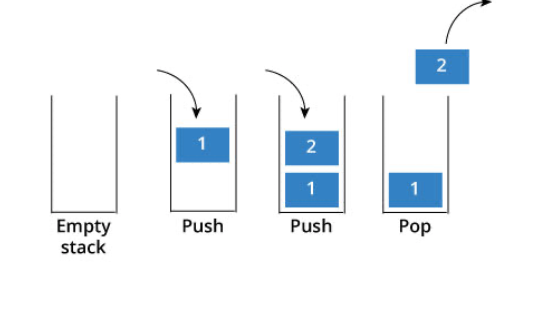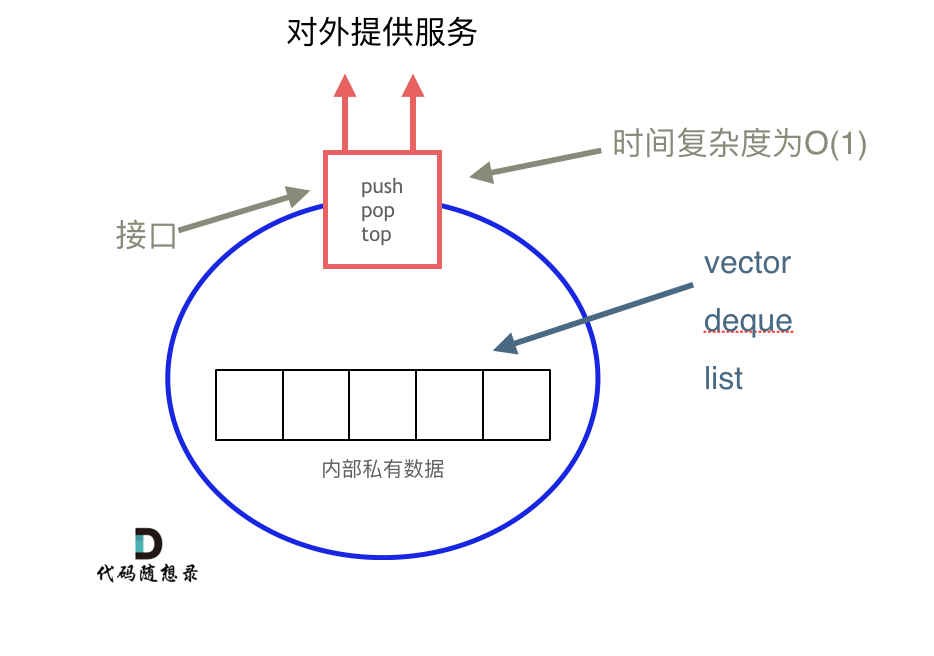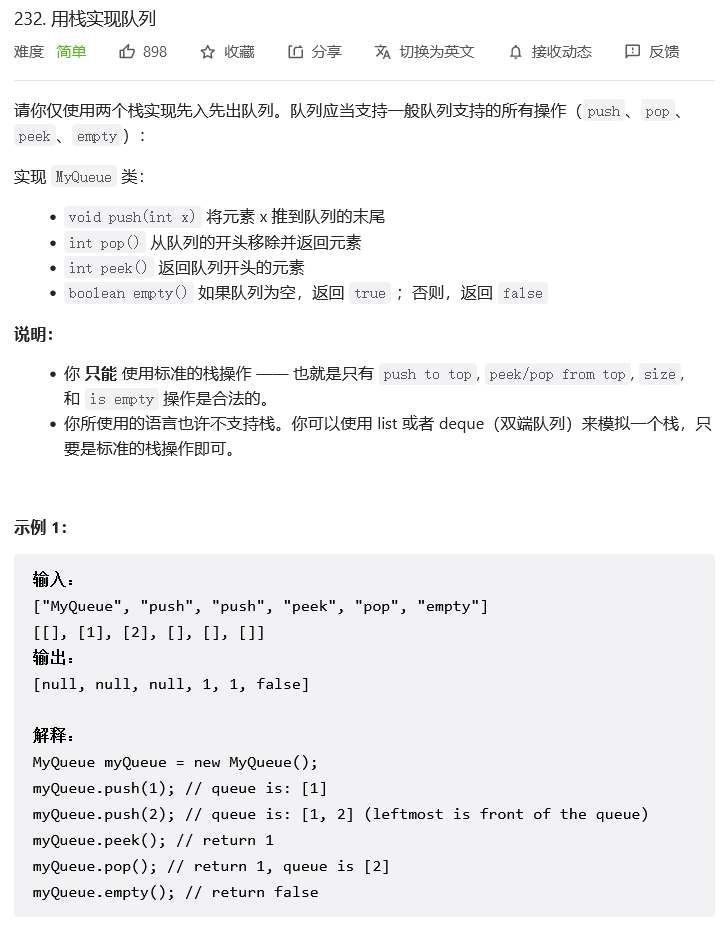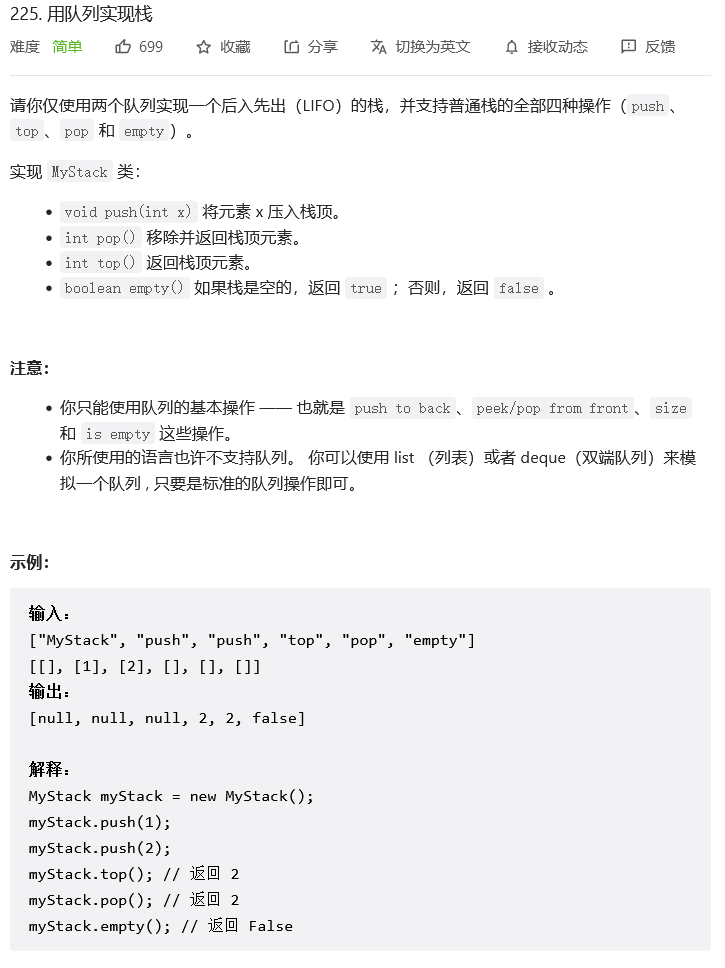1. 栈与队列理论基础
代码随想录: 原文
1.1 三个最为普遍的STL版本
- HP STL 其他版本的C++ STL,一般是以HP STL为蓝本实现出来的,HP STL是C++ STL的第一个实现版本,而且开放源代码。
- P.J.Plauger STL 由P.J.Plauger参照HP STL实现出来的,被Visual C++编译器所采用,不是开源的。
- SGI STL 由Silicon Graphics Computer Systems公司参照HP STL实现,被Linux的C++编译器GCC所采用,SGI STL是开源软件,源码可读性甚高。
接下来介绍的栈和队列也是SGI STL里面的数据结构
1.2 栈
栈先进后出

- 栈提供push 和 pop 等等接口,所有元素必须符合先进后出规则
- 栈不提供走访功能,也不提供迭代器(iterator)
- 栈是以底层容器完成其所有的工作,对外提供统一的接口,底层容器是可插拔的(也就是说我们可以控制使用哪种容器来实现栈的功能)
- STL中栈往往不被归类为容器,而被归类为container adapter(容器适配器)
- 栈的内部结构,栈的底层实现可以是vector,deque,list 都是可以的, 主要就是数组和链表的底层实现

- 常用的SGI STL,如果没有指定底层实现的话,默认是以deque为缺省情况下栈的底层结构
- deque是一个双向队列,只要封住一段,只开通另一端就可以实现栈的逻辑了
也可以指定vector为栈的底层实现,初始化语句如下:
std::stack<int, std::vector<int> > third; // 使用vector为底层容器的栈
1.3 队列
- 队列的情况与栈的特性是一样的
- 队列中先进先出的数据结构,同样不允许有遍历行为,不提供迭代器, SGI STL中队列一样是以deque为缺省情况下的底部结构。
- STL 队列也不被归类为容器,而被归类为container adapter( 容器适配器)
也可以指定list 为起底层实现,初始化queue的语句如下:
std::queue<int, std::list<int>> third; // 定义以list为底层容器的队列
2. 用栈实现队列
代码随想录: 原文
力扣题目 : 232.用栈实现队列

2.1 思路
- 使用栈来模式队列的行为,需要两个栈一个输入栈,一个输出栈
- push数据的时候,只要数据放进输入栈就好
- pop的时候,输出栈如果为空,就把进栈(输入栈)数据全部导入进来,再从出栈弹出数据,如果输出栈不为空,则直接从出栈弹出数据就可以了
- 如果进栈和出栈都为空的话,说明模拟的队列为空
代码实现
class MyQueue {
public:
stack<int> stIn;
stack<int> stOut;
/** Initialize your data structure here. */
MyQueue() {
}
/** Push element x to the back of queue. */
void push(int x) {
stIn.push(x);
}
/** Removes the element from in front of queue and returns that element. */
int pop() {
// 只有当stOut为空的时候,再从stIn里导入数据(导入stIn全部数据)
if (stOut.empty()) {
// 从stIn导入数据直到stIn为空
while(!stIn.empty()) {
stOut.push(stIn.top());
stIn.pop();
}
}
int result = stOut.top();
stOut.pop();
return result;
}
/** Get the front element. */
int peek() {
int res = this->pop(); // 直接使用已有的pop函数
stOut.push(res); // 因为pop函数弹出了元素res,所以再添加回去
return res;
}
/** Returns whether the queue is empty. */
bool empty() {
return stIn.empty() && stOut.empty();
}
};
- peek()的实现,直接复用了pop(),否则,对stOut判空的逻辑又要重写一遍
- 工业级别代码开发中,一定要懂得复用,功能相近的函数要抽象出来,不要大量的复制粘贴。
3. 用队列实现栈
代码随想录: 原文
力扣题目 : 225. 用队列实现栈

3.1 思路
注意: 题目强调是单向队列
两个队列实现栈
- 队列是先进先出的规则,如果使用两个队列来实现栈,把一个队列中的数据导入另一个队列中,数据的顺序并没有变,并没有变成先进后出的顺序
- 用两个队列que1和que2实现队列的功能,que2其实完全就是一个备份的作用
- que1最后面的元素以外的元素都备份到que2,然后弹出最后面的元素,再把其他元素从que2导回que1
- 这样数据的顺序就改变了
模拟的队列执行语句如下:
queue.push(1);
queue.push(2);
queue.pop(); // 注意弹出的操作
queue.push(3);
queue.push(4);
queue.pop(); // 注意弹出的操作
queue.pop();
queue.pop();
queue.empty();
一个队列实现栈
一个队列在模拟栈弹出元素的时候只要将队列头部的元素(除了最后一个元素外) 重新添加到队列尾部,此时再去弹出元素就是栈的顺序了
3.1 代码实现
两个队列实现栈:
class MyStack {
public:
queue<int> que1;
queue<int> que2; // 辅助队列,用来备份
/** Initialize your data structure here. */
MyStack() {
}
/** Push element x onto stack. */
void push(int x) {
que1.push(x);
}
/** Removes the element on top of the stack and returns that element. */
int pop() {
int size = que1.size();
size--;
while (size--) { // 将que1 导入que2,但要留下最后一个元素
que2.push(que1.front());
que1.pop();
}
int result = que1.front(); // 留下的最后一个元素就是要返回的值
que1.pop();
que1 = que2; // 再将que2赋值给que1
while (!que2.empty()) { // 清空que2
que2.pop();
}
return result;
}
/** Get the top element. */
int top() {
return que1.back();
}
/** Returns whether the stack is empty. */
bool empty() {
return que1.empty();
}
};
一个队列实现栈:
class MyStack {
public:
queue<int> que;
/** Initialize your data structure here. */
MyStack() {
}
/** Push element x onto stack. */
void push(int x) {
que.push(x);
}
/** Removes the element on top of the stack and returns that element. */
int pop() {
int size = que.size();
size--;
while (size--) { // 将队列头部的元素(除了最后一个元素外) 重新添加到队列尾部
que.push(que.front());
que.pop();
}
int result = que.front(); // 此时弹出的元素顺序就是栈的顺序了
que.pop();
return result;
}
/** Get the top element. */
int top() {
return que.back();
}
/** Returns whether the stack is empty. */
bool empty() {
return que.empty();
}
};
4. 总结
- 要了解编程语言里栈和队列的底层实现问题
- 功能相近的函数要抽象出来,抽象成一个好用的函数或者工具类
学习时间:100min





评论区